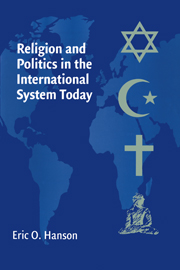Book contents
- Frontmatter
- Contents
- Acknowledgments
- Religion and Politics in the International System Today
- Introdution: The view from Silicon Valley
- I RELIGION AND POLITICS IN THE NEW GLOBAL PARADIGM
- II RELIGION IN CONTEMPORARY WORLD POLITICS
- 5 The West: Christianity, Secularization, and Immigration
- 6 East Asia: Modernization and Ideology
- 7 South and Central Asia: The Legacies of Gandhi and Khomeini and the Bomb
- 8 The Middle East and North Africa: Jewish and Islamic Politics
- 9 Latin America: Indigenous Religions, Christianity, and Globalization
- 10 Religion and Politics for the Next Millennium
- Appendix I Thirty Years of Nobel Peace Prizes, 1975–2004
- Appendix II Paradigm Chart and Category Questions
- Index
6 - East Asia: Modernization and Ideology
Published online by Cambridge University Press: 06 January 2010
- Frontmatter
- Contents
- Acknowledgments
- Religion and Politics in the International System Today
- Introdution: The view from Silicon Valley
- I RELIGION AND POLITICS IN THE NEW GLOBAL PARADIGM
- II RELIGION IN CONTEMPORARY WORLD POLITICS
- 5 The West: Christianity, Secularization, and Immigration
- 6 East Asia: Modernization and Ideology
- 7 South and Central Asia: The Legacies of Gandhi and Khomeini and the Bomb
- 8 The Middle East and North Africa: Jewish and Islamic Politics
- 9 Latin America: Indigenous Religions, Christianity, and Globalization
- 10 Religion and Politics for the Next Millennium
- Appendix I Thirty Years of Nobel Peace Prizes, 1975–2004
- Appendix II Paradigm Chart and Category Questions
- Index
Summary
Following the Cold War, East Asia (China, Japan, Korea) has become the globe's second most powerful region economically, militarily, and politically. Unlike Western Europe (France, Germany, Great Britain), North America (Canada, Mexico, the United States), and South America (Argentina, Brazil, Chile), these three East Asian countries have legitimately harbored little trust for each other, resulting in high militarization throughout the region. The Korean peninsula constitutes one of the world's four major flashpoints for a nuclear war. East Asia also contains the second, the Taiwan Strait, with Kashmir and the Middle East located in South and West Asia respectively. East Asia has thus become an area of great hope and great danger.
Despite the traditional antipathy between the Koreans and the Japanese and the unique tension-filled relationship between the Chinese and the Japanese, historical and cultural links do remain. Whereas autonomous and politically engaged religious and secular institutions characterize the West, East Asia has experienced the unified political-religious legitimacies of the state in Confucian and Maoist forms, and the separate tradition of Mahayana Buddhism. Korea and Taiwan have produced strong indigenous Buddhist and Christian traditions. Although their cultures and spoken languages preexisted the borrowing, the Koreans and the Japanese did adopt the Chinese writing system and facets of Chinese art and literature. Buddhism and Confucianism profoundly influenced all three countries, with neo-Confucianism eventually winning out among the political elite in ninth-century China, fifteenth-century Korea, and seventeenth-century Japan.
- Type
- Chapter
- Information
- Religion and Politics in the International System Today , pp. 164 - 197Publisher: Cambridge University PressPrint publication year: 2006



